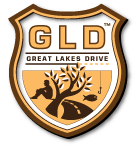
What’s To Love About North House Folk School?
If I was asked to pick one place that represents the beautiful heritage and adventurous spirit of the North Shore, it would have to be North House Folk School. Beautifully set on the shores of Lake Superior, North House offers a treasure of skills, learning, and experiences. GLD had a chance to speak with the Executive Director of North House and discovered a person with the heart and passion of one you would expect to pilot a resource so great that it cannot be ignored.
When we set up our camera you could hear the gulls in the background and smell the fresh scent of thinly cut cedar wafting out of the open doors of the shop.
Below is a transcription of the interview and links to the videos that demonstrate the passion and energy of North House Folk School.
Question: What Do You Love Most About North House?
GLD: So what do you love about North House?
Greg Wright: Elena, that is a great question. So many things, but one of the things I really love about the school is that when people walk on to this campus, with every sense, they understand what we do here. They can feel it. They can smell it. They can hear it. And that’s because the traditional craft is such an inspiring thing. So what do I mean? Let me give you some examples.
“People walk into the wooden boat shop and there’s a wood canvas or cedar strip canoe being built, and their eyes go wide and they know right away, they’re in northern Minnesota. They know what a canoe is, but then their nose smells that cedar and they go, “Ohh… I want to get my hands on that thing! I’ve always wanted to build one of those since I was a kid.”
Or their ears pick up, in the distance, “ping… ping…” and it is like the siren call. The hammer swinging on the anvil in the blacksmith’s shop. And they turn, and they are drawn over there to investigate. Or, people baking in the wood-fired oven. I mean, for a long time the world has thought you turn on your stove, mr. electricity makes heat, and that’s how you cook things. But actually, humans have been cooking things for a long time using fire, and it’s unlike anything else, and so, a group of students is pulling flatbread out of the wood-fired oven, and people come over to check it, out and pretty much right away their tastebuds and their nose let them know that there’s something real here that they’ve got to get their hands on and that’s really whats so cool, is people understand pretty quickly, their nose, their ears, their taste buds tell them, my hands have to get on this stuff. There’s something real here that I understand. It’s a great part of North House.
Watch the interview and see how Greg Wright reacts when we tell him that the videographer forgot to turn the microphone on for the first question and we’ll have to retake. You won’t want to miss it!
Question: What Are Traditional Northern Crafts?
GLD: In your mission statement, you say “Traditional Northern Crafts.” What does that mean?
Greg Wright – Wow. Three great words and so much meaning. You know, obviously, in today’s world we live a pretty charmed existence in a lot of ways. We have smartphones that help us find wherever we need to go. We have stores where we can get asparagus in summer, spring, winter, and fall. And we get to move across the landscape, effortlessly. Well you know, actually in human history, it hasn’t always worked that way. What were the highways of the world? Well, it was either traveling across snow or it was traveling on the water because that’s how you moved. Where was the food? Where was the grocery store? Well, the grocery store was out your back door. Right? And where was the hardware store? Well, it was out your back door too, or maybe out your front door. The point is, the resources were there and your job was to somehow use them to fashion your life.
“…And what’s joyous about traditional northern crafts is it brings alive at once the story of the landscape, the resources that were there, but also the story of the people and their connection to those resources.”
Great example, if you want to transport yourself in northern Minnesota, across the watery highway, the ten thousand lakes, you build yourself a birchbark canoe. Because that was your mode of transport. And of course, you didn’t build a seal skin Inuit kayak, like they would have in Greenland because we don’t have seals here. But similarly, they don’t have birchbark there. So they build their boats out of skin. So traditional northern crafts are about all the things people did, all the things wrapped together, that made their lives possible. Making moose hide mucklucks, so they could dance in the snow. Making wood-fired bread so that they could eat and sustain themselves. Carving wooden bowls, because how are you going to feed your family? What are you going to store that wild rice in? So, harvesting wild rice, making baskets, carving bowls, making clothing, all the things people needed to do.
“…And what’s interesting is long ago, of course, how did you learn those skills? Well, you asked your mom or dad, or you asked your grandma and grandpa because those things were going on in your life all around all the time.”
Well, how do we learn those skills today? Those skills are starting to vanish. And so we either choose to pass them on through schools like North House, or we let them go. And our belief is, if we’re going to keep our lives rich, remember the stories that matter about the world, we need to connect the past the present and the future and part of that is bringing these skills forward with us, to make the world a more interesting, more inspiring, more satisfying place to call home.
Watch the interview and make sure to check out North House Folk School’s website using the links on this page!
A big thank you to Mr. Wright and North House Folk School for allowing us to take their time and capture the beautiful North House location for this article. If you would like to see the trailer for what should be your next big adventure, click below and meet one of the instructors, Mark Hansen (NHFS Pram Boat Buiding Instructor) and find out more about this wonderful resource!
GLD: To find out more about North House Folk School, use the link below.
North House Folk School – Click Here
Greg Wright is the Executive Director of North House Folk School. He has been immersed in educational nonprofit leadership his entire career. Arriving at North House in its fourth year, he has relished its strong community, powerful mission, and steady evolution. Northerner travelers by nature, Greg, his wife Jeanne, and daughter Olya prefer life outdoors. Chickens, bees, garlic, birch firewood, a CSA and some fiddling keep them moving.

written by: Elena B/em>
About the author: Elena loves the North Shore, camping, spending time with her giant German Shepherd, and just about anything that will let her put her wetsuit on and climb into her kayak. Watch for more videos featuring Elena at Great Lakes Drive.com
Enjoy!

